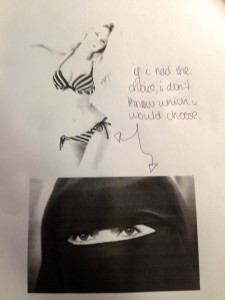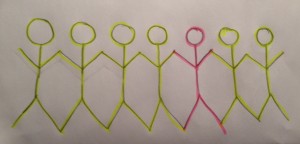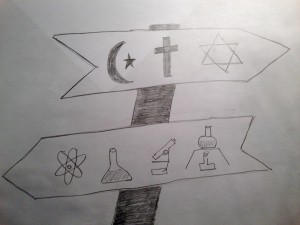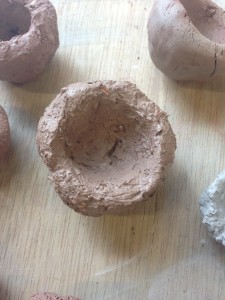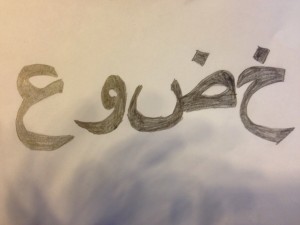-
Recent Posts
Recent Comments
Archives
Categories
Meta
Emma's Blog: Muslim Voices In Contemporary World
Just another Weblogs at Harvard Law School site
“The Burka and The Bikini” Creative Response
Although this particular text was not an assigned homework reading for the course, the most memorable piece that I read this semester was “The Burka and The Bikini” by Joan Jacobs Brumberg and Jacquelyn Jackson. In short, this piece summarizes many of the major concepts that we highlighted particularly that of the outlook the western world has on the stereotypes of the Islamic faith. I had never really thought of making the comparison between an American women wearing a bikini to a Muslim woman wearing a burka. Brumberg and Jackson write, “whether it’s the dark, sad eyes of a woman in purdah or the anxious darkly circled eyes of a girl with anorexia nervosa, the woman trapped inside needs to be liberated from cultural confirmed in whatever form they take”. After reading this article, it made me look at my own culture in a very different light. Before reading this article, I have to say that I didn’t properly understand why women wore Burka’s and I definitely never made the assumption that women wear bikinis as a form of oppression. However, this article gave me insight into how both my own culture is very alike to a culture that I thought was far more distant to my own that I thought it actually was.
For my creative response, I chose a photo of a victoria secret model in a bikini, and a woman in a burka. I chose to write next to it, “if I had the choice, I don’t know which I would choose” signifying how both the woman in the bikini and the woman in the burka are being oppressed in completely separate ways that in turn make up the mold of the societies that we know.
“Madras on Rainy Days” Creative Response
Madras on Rainy Days by Samina Ali focuses on the morphed societal pressures and expectations. In her novel, she highlights the life of a Muslim woman and shows the injustices women still face to this day. Layla, the main character, is presented with many real life situations that show how at times it is easier to slip into a world where you do what is expected of you, not what you want to do or believe in. Although Layla was exposed to the western culture of liberation and a world of opportunities, she decides to move back to India where her family has set up an arranged marriage. The marriage does not work because her husband ends up being gay, so Layla is not able to fulfill the role of being a mother which is society, especially her parents, expect from her. Because Layla is torn between two worlds, America and India, she has no real sense of belonging. She has experienced the freedom of the western culture however her roots and traditions lie in India. With this in mind, Layla conforms to societal pressures but deep inside she is different.
To represent a sense of societal pressures, I chose to draw out a line of people (note: please ignore the fact that they are stick figures – I can not draw). In this line, all but one of the people are colored yellow. The one person that is colored pink represents Layla and her vision for a different culture however with the societal pressures she conforms to, she is still standing in the line with the others. The different color represents the fact that she knows and wants something else, but due to an abundance of pressures from her family, she must stay with her heritage.
“Complaint and Answer” Creative Response
Throughout the poems Complain and Answer by Muhammad Iqbal, the theme of gardens come up on many different occasions. In seminar, we learnt that a garden is a place of rest and reflection. Interestingly enough, in these poems, Iqbal tends to associate the garden with perhaps the decay of the Islamic faith. In this way, Iqbal writes, “Shame it is, the garden’s blossoms should themselves the traitor play” (Iqbal, 30) perhaps representing the people of the Islamic faith have betrayed themselves by in a way being too faithful to their religion. Iqbal goes on to write that “the garden’s Lyre is broken, and the roses’ bloom time sped” (Iqbal, 30). These are all images of decomposition and deterioration that go side by side with the previous quote. With this in mind, I find it really interesting how Iqbal uses the imagery of flowers, which is a sacred symbol in the Islamic faith, to represent something that is not at all sacred.
For my creative response, I chose to photograph a flower that I thought was particularly beautiful. Although the poem uses flowers as a way to represent decay, I chose a fresh, colorful flower to symbolize the truer meaning of a garden not in terms of this piece but in general to the Islamic piece. Throughout this seminar, we have discovered many pieces that highlight a rose, or for that fact, nature. A garden is a “reminder of paradise” (Wikipedia, “Islamic Garden”). For example, some of the most famous Islamic Gardens include the Taj Mahal. An Islamic Garden is purely a place for contemplation not walking like an English Garden. The flower in my photo represents the imagery in my head of an Islamic Garden.
“The Beggars’ Strike” Creative Response
I made this comparison in my journal the week that we read The Beggars’ Strike by Aminata Sow, however, I wanted to find a way to creatively respond to it as well. I want to put the story of The Beggars’ Strike into dialogue with the recent events in the London Tube strikes. Being a transportation officer isn’t necessarily a very high paying job. With the modern economy, many jobs are being cut and wages are being lowered, thus those at the bottom of the social stratum are being really screwed over. Due to the power of the unions in the United Kingdom, the transportation officers and union has made decisions to strike on multiple occasions. When this happens, of course the city goes wild and as expected, everything is extremely chaotic. I am making this comparison to represent the fact that when one small, unappreciated part of society is removed, often times there are consequences than many people take for granted and don’t realize the severity of until it actually happens. In regards to The Beggars’ Strike, the drastic shift in society when the beggars are not in the city is similar to the shift when the transportation officers go on strike.
To represent this social hierarchy, I made a pyramid with objects that I have lying around my room. When one part of the pyramid is taken out, everything falls down. To show that, I videos myself pulling out the can of Digestive Cookies from the bottom which is one of the stabilizers. When this happens, all the other objects sitting above come crashing down. The beggars in The Beggars’ Strike disappear, society can not function right, likewise with out the tube drivers the city of London is an absolute wreck where nothing functions properly either.
“The Saint’s Lamp” Creative Response
An important question that reoccurs during “The Saint’s Lamp” by Yahya Haqqi is the controversy over science and religion. This question seems to arise when Ismail returns home after studying medicine in England. His religion begins to pose difficulties in the methods and practices that in turn makes him struggle with finding the right balance between religion and science. Religion is a huge influence into people’s beliefs regarding medical attention. In the end, Ismail is forced to combine his faith and science to work hand in hand in order to make an impact on his community. Haqqi writes, “he only held to the spirit and basis of his science, abandoning all elaborate instruments and techniques. He relied first upon God, and secondly on his learning and the skill of his hands” (Haqqi, 37).
For my creative response, I designed a signpost that signified science pointing to one way and religion pointing the other. When relating this story to my culture, the issue that tends to come up often is that of abortion. Although I am not catholic, the controversy over abortion is often debated throughout the united states, especially in terms of the law. Many people have a hard time justifying abortion because of their religion due to the fact that it may go against their scripture. Likewise, in “The Saint’s Lamp” this issue is raised through the point of view of a doctor versus his Islamic faith. We face this controversy in many different societies throughout the world.
“Persepolis” Creative Response
Every person sees the world through a different lens, some for the better and some for the worse. In “Persepolis” by Marjane Satrapi, the comic tells stories from her childhood through an innocent lens, one that is often to true to be reality. The stories reflect her life in Iran during the war between Iraq and Iran. Through her stories, it made me think about the important of perspectives and how a particular perspective can alter the way we may see things in the future. In the case of this novel, Satrapi uses a childs voice to illustrate life during the war which adds a particularly interesting touch to the stories.
In my artwork for this novel, I chose to represent different perspectives by drawing a girl with glasses and one without. In short, glasses are used to enhance a persons eyesight thus allowing them to see things that perhaps prior to wearing glasses they could not see clearly. Glasses are a tool that gives people a different perspective, literally. Although glasses may not change a persons perspective regarding opinions or beliefs, it does however represent a change in what a person is able to see clearly.
The novel’s content really forces people to think about how they view others. By sharing the story of a young girl in Iran, it makes people recognize that everyone has had different life experiences. It is easy to judge people from afar without truly understanding where they come from. Through my drawing, I hoped to capture the fact that each person has a different perspective, and sometimes we all need to wear a pair of virtual glasses to see that more clearly.
“Children of the Alley” Creative Response
Children of the Alley written by Naguib Mahfouz is a complex story that combines the histories of the three monotheistic Abrahamic religions (Judaism, Christianity and Islam). With this thought in mind, it raises the question about the origins of a religion and when a new religion can be formed. Mahfouz intertwines the monotheistic religions by humanizing their stories thus giving people a depiction of who God is. This in itself is a daring move and created much controversy about the humanization of God and how that may be potential offensive. In that, there is also the question on how each of these religions were formed and when a new religion can be formed. The monotheistic religions stem from each other and therefore all have their similarities and differences. Each religion is made up of many different building blocks.
My creative response for this particular novel is a bit of stretch however I think it is something that can be interpreted in many different ways. I chose to relate the forming of a pot to Children of the Alley in respect to the fact that a pot needs many different ingredients in order for it to form the clay that will eventually create the pot. Once the clay has been formed, one has to mold the clay to form a pot. The final product is then the pot. This process represents the same that religion has gone through. Religion is created from many moving parts, which then sticks together and is adapted to create a singular faith for people to follow. The pot represents the religion, which in this case is Islam, is a place that holds together and is an intricate part of the lives of many people around the world.
“An Egyptian Childhood” Creative Response
My creative response to An Egyptian Childhood is the Arabic word of “submission”. I chose to write the word out in Arabic not only because it is the core of the story but also for the simple artistic appeal of the Arabic script. This story particular shocked and intrigued me in a sense that shows how Islamic faith relies on submission to God, after all that is what early Islam meant. In An Egyptian Childhood, it is evident that everything in the village is based around the religion, from schools, to medicine to the daily social structure. This is all due to the submission that the people give to god, something that often lacks in other cultures especially many of those in the modern world.
In class we learnt about how the Arabic script is often sold as art, particularly just one word. People buy these pieces and hang them, almost as if it is a type of protector. Other forms of art include creatively and intricately designed pieces that intertwine the Arabic script that can be displayed almost anywhere. The word “submission” is a piece that reflects the basic understanding of Islam as a whole, and the story behind An Egyptian Childhood.
“We Sinful Women” Creative Response
You look left, you look right, you look straight ahead or behind and you will most likely see women. Women are everywhere in this world and should in theory represent the same level of power as men. In high school I took a semester of Women’s Literature, however, I have never really been exposed to feminity through the eyes of an Islamic woman. After reading the poems in the collection We Sinful Women translated and edited by Rukhsana Ahmad, the general theme that I cam across was the sense of pain and suffering as we move towards equality.
As my creative response, I compiled a collection of photos of women who I find particularly inspiring. One of the main reasons why I chose to row for Harvard was the sense of pride that all women rowers at Harvard take in calling ourselves Radcliffe Crew. We to this day still identify ourselves by Radcliffe as we represent the women of the past and wish to continue to include that in our legacy at Harvard and rowing for Radcliffe. The women in the photos that I decided to include for my creative response are all part of the Radcliffe crew team and are a vital and integral part of the movement towards equality one step at a time on the Harvard Campus. To put this in dialogue with We Sinful Women, pain and suffering for women is universal and and more we spread the word and attempt to make a difference – it can only make a positive impact for the women of future generations.
